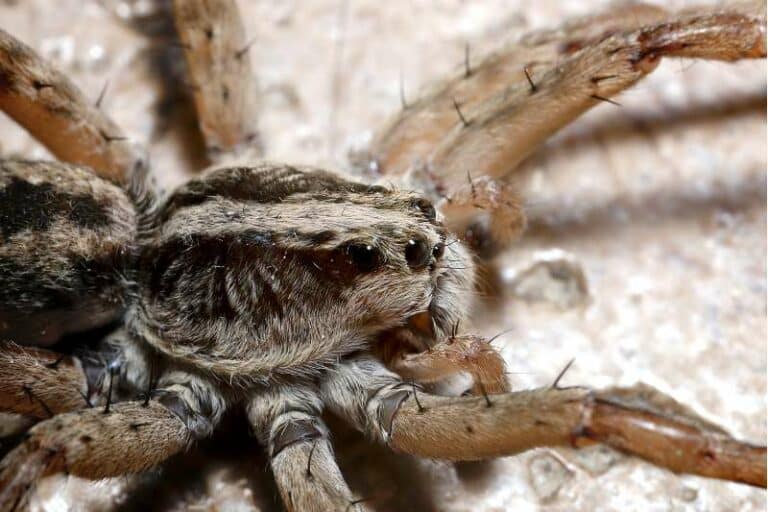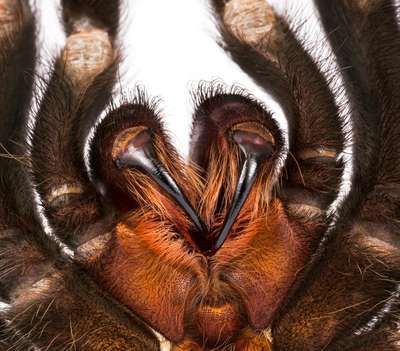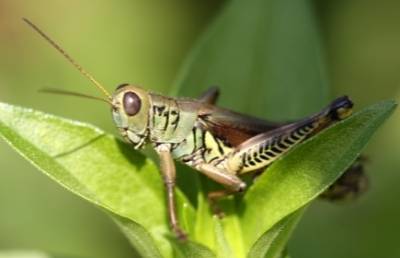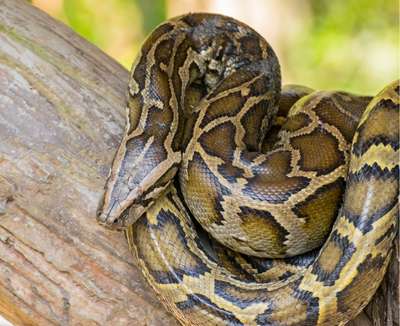Eastern Tiger Swallowtails are, without a doubt, the largest and most flamboyant butterfly found in the southeastern United States. Whenever I hear a group of people oohing and ahhing over something in a stand of flowers in a sunny meadow, I can almost guarantee that they’re watching an Eastern Tiger Swallowtail put on a show.

Fun Facts About Eastern Tiger Swallowtail Butterflies To Wow Your Friends
My absolute favorite thing to do after I identify a butterfly is to learn everything I can about it.
Every species on earth is unique and has its own quirks, hidden talents, enemies, and friends. I call these special tidbits “fun facts” because that’s what they are to me.
Here are a few fun facts about Eastern Tiger Swallowtail butterflies that I hope you enjoy too!
- Eastern Tiger Swallowtail butterflies are “polymorphic”. This means that individuals look very different from each other in a variety of ways.
- First, they are sexually dimorphic. Sexual dimorphism means that males and females look different from each other. This is a common type of dimorphism in butterflies. Female Eastern Tiger Swallowtail butterflies have large patches of bright blue scales on their hindwings, which males lack.
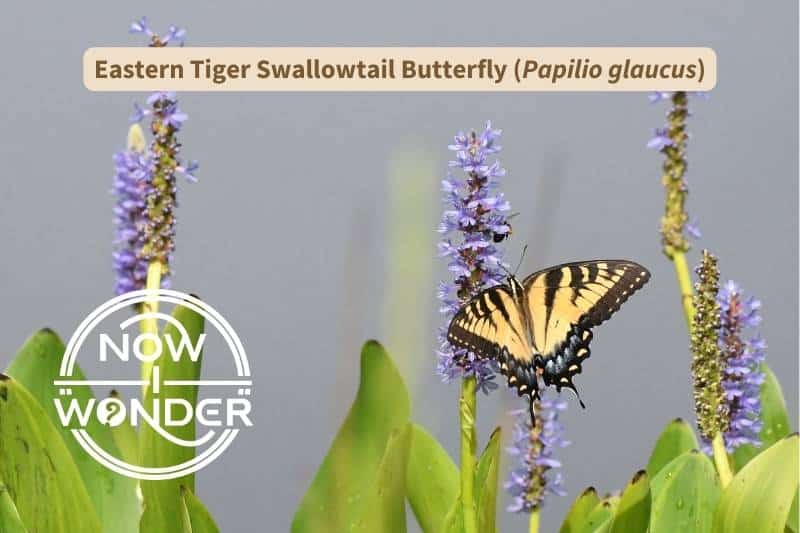
- Second, females are dimorphic in that they come in two different forms, or “morphs”, one yellow and one black.
- Yellow-morph females look exactly like males except for the patches of blue on their hindwings.
- Black or dark-morphs resemble a cousin swallowtail species, the Pipevine Swallowtail (Battus philenor).
- Pipevine Swallowtail butterflies are notoriously toxic to predators. Most butterfly predators actively avoid attacking them.
- Dark-morph Eastern Tiger Swallowtail butterflies likely gain protection from predators by mimicking their much smaller, but dangerous cousin.

- Male Eastern Tiger Swallowtail butterflies decide which females to mate with.
- Mating requires a lot of energy from both males and females. Males lose nutrients with every mating. Male Eastern Tiger Swallowtail butterflies want to mate with virgin females (Klein and Araujo 2010).
- Male Tiger Swallowtails sometimes stake out chrysalids, hoping the butterflies inside are females.
- This is a potentially costly strategy. There is only a fifty-fifty chance that an emerging butterfly will be female.
- If a male emerges, the hopeful male will have wasted both time and energy.
- But when he guesses right, he wins the reproductive lottery. He gets to mate with a virgin female, who has not yet expended her own energy and resources mating with other males.
- This is a potentially costly strategy. There is only a fifty-fifty chance that an emerging butterfly will be female.
But fun facts are a whole lot more fun when you get to see the actual animal in real life. So read on to find out where, when, and how to find Eastern Tiger Swallowtail butterflies, and how to know you’re looking at the animal you think you are. You’ll be so glad you did!
How Do I Know I’m Looking At An Eastern Tiger Swallowtail Butterfly?
Appearance of Eastern Tiger Swallowtail Eggs
Female Eastern Tiger Swallowtail butterflies lay one egg at a time. They deposit the eggs on top of a host plant’s leaves (Daniels 2003). The eggs are green, round, and very large for butterflies, about 1/32 inches high by 3/64 inches wide (0.8 x 1.2 mm) (Pyle 1981).
Appearance of Eastern Tiger Swallowtail Caterpillars / Larvae
Eastern Tiger Swallowtail caterpillars start life disguised as bird droppings. They hide in plain sight through their first three growth periods (called “instars”). Then they turn into smooth-skinned green caterpillars. They grow to about 2 inches (5.5 cm) (Wagner 2005).
Their bodies bulge behind their heads, then taper. Two small black, blue, yellow, and white spots decorate the bulge behind their heads. These spots look like eyes and come complete a narrow black line that looks like an eyebrow (Wagner 2005).
A thin yellow line edges the first abdominal section. This line is only visible when the caterpillar is slightly stretched out. Otherwise, the stripe is hidden in the fold between the body sections.
Eastern Tiger Swallowtail caterpillars are “counter-shaded” (Wagner 2005). Their backs are dark green but the color lightens gradually down their sides. Eastern Tiger Swallowtail caterpillars rest on top of leaves to feed. Their counter-shading helps them blend into the background and avoid notice by predators.
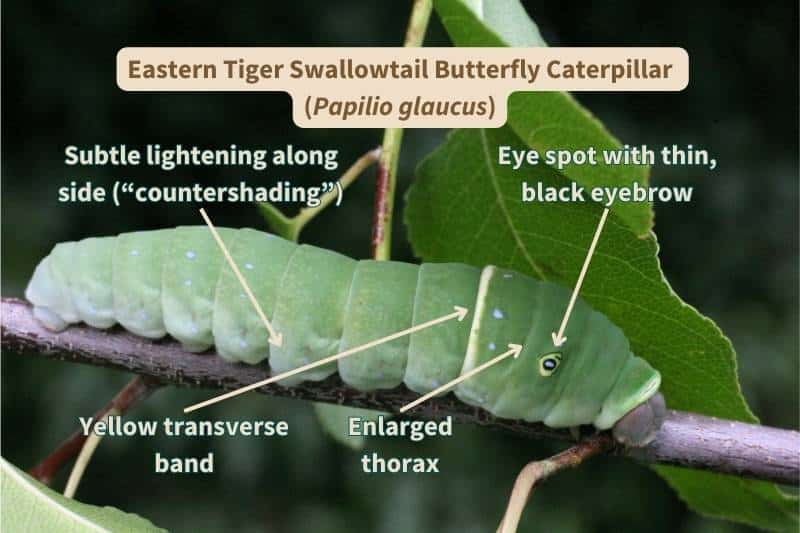
Eastern Tiger Swallowtail chrysalids are mottled green or brown, about 1.25 inches (32 mm) long (Pyle 1981) and belted with a single strand of silk.
Appearance of Adult Eastern Tiger Swallowtail Butterflies
You’ll know you’re looking at an Eastern Tiger Swallowtail butterfly when you see a very large, yellow butterfly with black forewing stripes. Their wings span up to 5.5 inches (14.0 cm). Their hindwings are banded in black, and a single long tail projects from each hindwing.
Males are always yellow with black forewing stripes. Their eyes and antennae are black. Their bodies are yellow with black lengthwise stripes. At most, male Eastern Tiger Swallowtail butterflies have only a tiny spot of blue on their wings.
In contrast, females always have large patches of bright blue on their hindwings.
Female Eastern Tiger Swallowtail butterflies also come in two different color forms. Each color form is referred to as a “morph”.
The first color form is the “yellow morph”. Yellow morph females look like males. They have yellow wings, black forewing stripes, and black wing margins, plus the blue hindwing scales that identify them as females.
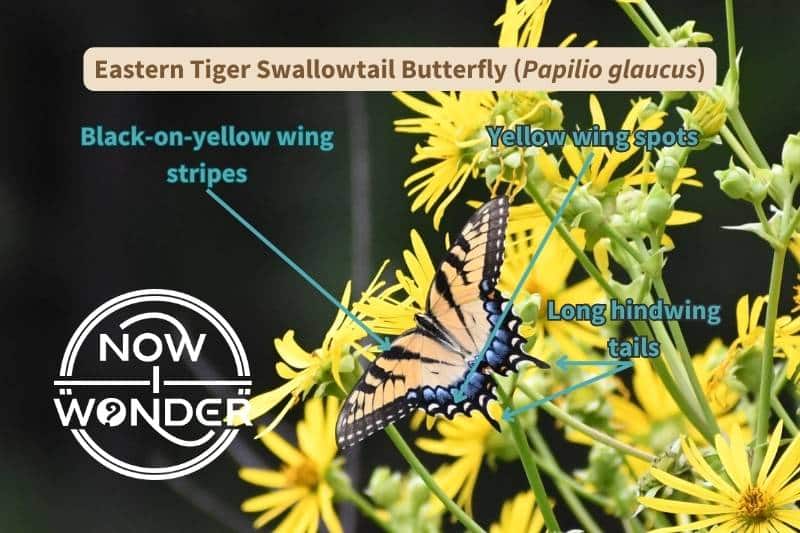
The second color form is the “dark morph”. Dark morph females have no yellow on their wings; the yellow is replaced with black. Their wings retain the black wing stripes that characterize this species but these stripes are only visible when the angle of light is just right. Otherwise, their wings look velvety black.
The combination of black wings and blue hindwing patches make dark morph Eastern Tiger Swallowtail butterflies look like Pipevine Swallowtails (Battus philenor). Pipevine Swallowtail butterflies are also found in North Carolina. They are toxic to predators and avoided by most. By mimicking their inedible cousins, dark morph Tiger Swallowtails gain much of the same protection from predators.

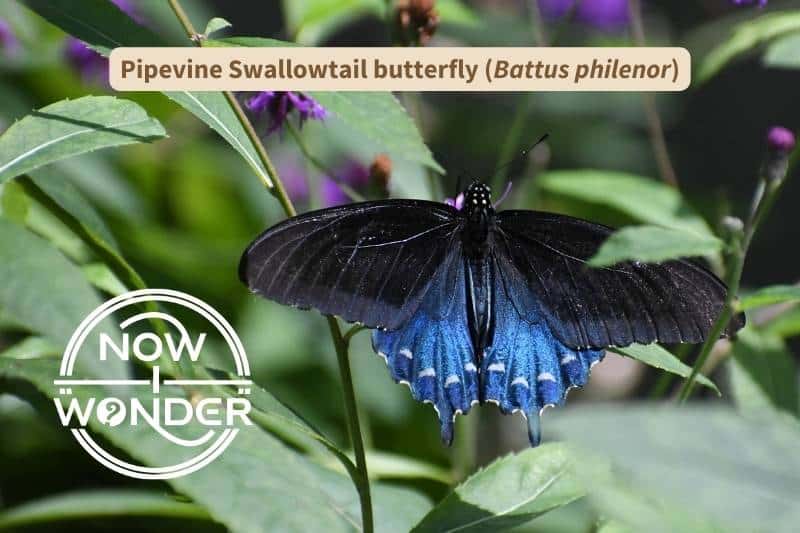
The underside of their wings show the same black stripes as seen on the upper surface. Both males and females have a row of large blue scales embedded in the black margin along their hindwings, and small orange spots.
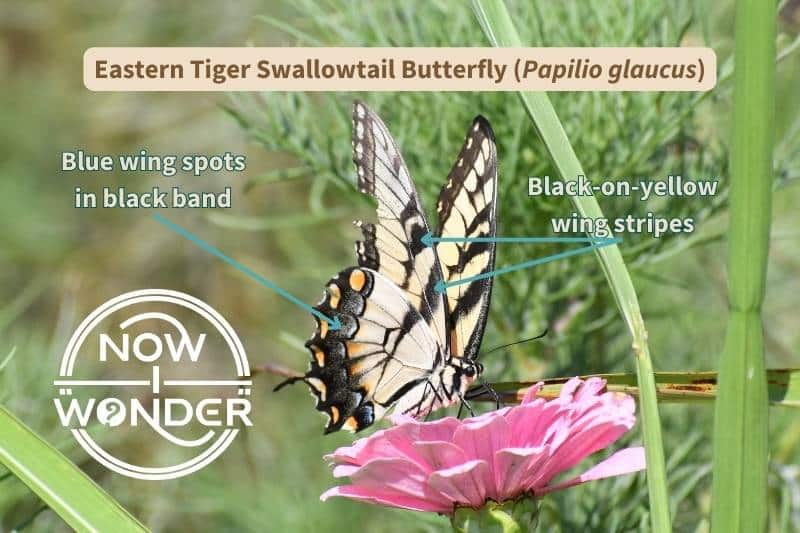
When Can I Find Eastern Tiger Swallowtail Butterflies in North Carolina?
Eastern Tiger Swallowtail butterflies appear in North Carolina in early March. They fly throughout the summer until about early November.
Caterpillars overwinter in chrysalids until temperatures warm in the spring. Then they emerge as adults and become the first generation.
Where Should I Look To Find Eastern Tiger Swallowtail Butterflies in North Carolina?
Look for Eastern Tiger Swallowtails along the edges between meadows and forests. They visit both flowery meadows and forests, but prefer the areas along the edge of both habitats.
Eastern Tiger Swallowtail butterflies are “edge habitat” specialists”. The first several stages of their lifecycle happens in the forest. Female Eastern Tiger Swallowtails lay their eggs on forest trees. Caterpillars hatch, feed on their leaves, and metamorphose into adults within the chrysalids they anchor to tree stems. But once they emerge, adults drink nectar from flowers found in meadows, fields, and gardens.
So, more individuals are likely to be along the edges of flowery meadows and forests at any given time of day (Siu et al. 2016) than deep in either area.
When spooked, Eastern Tiger Swallowtail butterflies fly towards the woods and up into the trees. These butterflies are strong fliers. They fly higher in trees than many other butterflies. And they can be surprisingly difficult to keep track of despite their large size. This is especially true of dark morph females. They can all but disappear into shadows if you don’t see exactly where they land.
Also, keep an eye out for mud puddles and patches of damp ground, especially in mid-morning. Male Eastern Tiger Swallowtails are avid “mud-puddlers”. Large numbers of them gather around mud puddles and damp ground. They do this to get sodium, which dissolves into the water. Sodium is important to successful mating in Eastern Tiger Swallowtail butterflies. Nectar is a poor source of sodium so this species must get it by puddling.
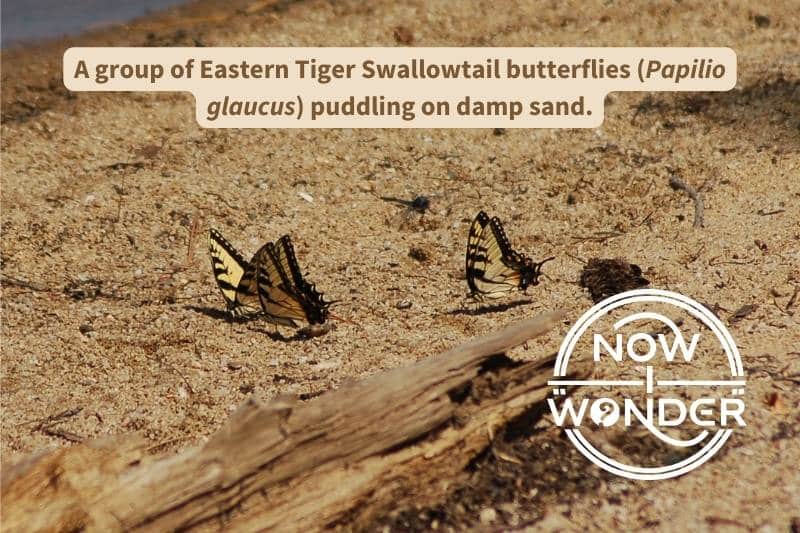
Puddling is a risky behavior. A group of large, fluttering, bright yellow butterflies can attract attention from predators. But it’s an easy and exciting way for amateur naturalists to spot Eastern Tiger Swallowtails in the wild.
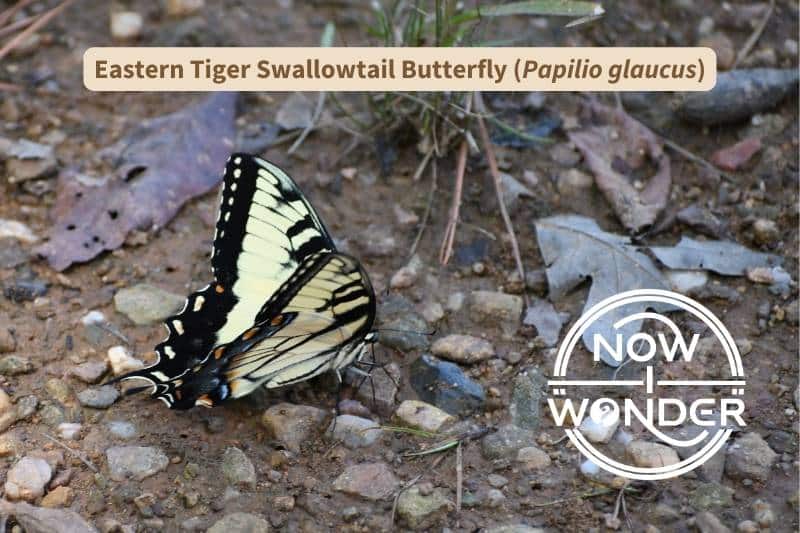
What Do Eastern Tiger Swallowtail Butterflies Eat?
Eastern Tiger Swallowtail Caterpillar Food Plants
Eastern Tiger Swallowtail caterpillars feed on a variety of forest plants. In North Carolina, their common food plants include:
- Tulip tree (Liriodendron tulipifera)
- Black cherry (Prunus serotina)
- White ash (Fraxinus americanan)
- Sweet Bay (Magnolia virginiana)
The leaves of Tulip Tree and Sweet Bay contain toxic compounds that deter many herbivores, and protect the plants from being defoliated. Eastern Tiger Swallowtail caterpillars can eat these chemicals without hurting themselves. They just excrete the toxic compounds (Frankfater et al. 2005). Interestingly, Eastern Tiger Swallowtail caterpillars don’t store the toxins they consume in their body tissues.
So the caterpillars can exploit a food source that is unavailable to many other competitors but can’t use the toxic chemicals they ingest to deter predators, like some butterflies do. Eastern Tiger Swallowtail caterpillars remain are entirely edible to their many predators.

Eastern Tiger Swallowtail Butterfly Food Plants
Adult Eastern Tiger Swallowtail butterflies eat nectar from flowers with long petals and seem to prefer red, pink, and purple flowers (Daniels, 2003).
North Carolina wildflowers that serve as nectar sources for this species include:
- Butter Milkweed (Asclepias tuberosa)
- Common Milkweed (Asclepias syriaca)
- Wild Lupine (Lupinus perennis)
Other flowers from which they feed include:
- Wild Bergamot (Monarda stulosa)
- Hairy Beardtongue (Penstemone hirutus)
- Dwarf Blazing Star (Liatris cylandracea)
- Purple Vetch (Vicia spp.)
- Clover (Trifolium spp.)
- Bouncing Bet (Saponaria oficianalis)
References
Daniels, Jaret C., 2003. Butterflies of the Carolinas. Cambridge, MN: Adventure Publications Inc.
Klein, Andre Luis, and de Araújo, Aldo Mellender. Courtship behavior of Heliconius erato phyllis (Lepidoptera, Nymphalidae) towards virgin and mated females: conflict between attraction and repulsion signals?. Journal of Ethology 28, 409–420. https://doi.org/10.1007/s10164-010-0209-1
Pyle, Robert Michael, 1981. National Audubon Society Field Guide to Butterflies. New York, NY: Alfred A. Knopf.
Siu, Jenna C., Daria Koscinski, and Nusha Keyghobadi. 2016. Swallowtail Butterflies show Positive Edge Responses Predicted by Resource use. Landscape Ecology 31 (9) (11): 2115-2131. https://doi.org/10.1007/s10980-016-0385-7
Wagner, David L., 2005. Princeton Field Guides: Caterpillars of North America. Princeton, NJ: Princeton University Press.



